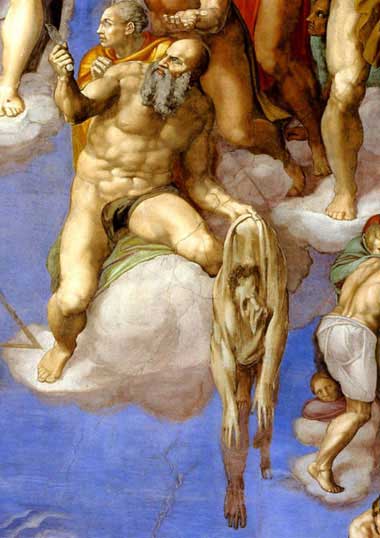If St. Bartholomew's Day be fair and clear,
Then a prosperous autumn comes this year.
St. Bartlemy's mantle wipes dry
All the tears that St. Swithin can cry.*
~ Traditional English proverb
St. Bartholomew (wiki), who is mentioned in three of the Gospels as an apostle and may be the Nathanael of John 1:45-51 and 21:2. According to tradition, he was flayed alive and then beheaded in Armenia and thus is often portrayed with a large knife and occasionally his own skin flung over his arm.
For obvious reasons, Bartholomew is the patron saint of tanners; it is less obvious why he is also the patron saint of plasterers and cheese merchants**. From 1133 to 1752, London's great Smithfield fair began on this day and was also known as St. Bartholomew's Fair partly because of its proximity to the ancient hospital of that name.
It's also the anniversary of the St. Bartholomew's Night Massacre (wiki) in 1572, when French king Charles IX - urged on by the dowager queen, Catherine di Medici, ordered the slaughter of Huguenots throughout France on the saint's feast day.
 |
| An Eyewitness Account of the Saint Bartholomew's Day Massacre by François Dubois |
The massacre was timed to coincide with the wedding of Henry of Navarre (later Henry IV) in Paris, which attracted many prominent French Protestants to the capital. Admiral Gaspard de Chatillon, Comte de Coligny (1519-1572) was the first to die, followed by 2,000 more victims in Paris and perhaps 10,000 in all of France (although accounts differ).
When the news reached Rome, Pope Gregory XIII ordered a Te Deum and had all the city's church bells rung in thanksgiving. The St. Bartholomew's massacre became a major cause celebre among European Protestants and in France re-ignited the Wars of Religion, which lasted until 1598.
* N.B. The reference here is to the traditional belief that if it rains on St. Swithin's Day - 15 July - 40 more days of rain will follow.
Brief documentary on the massacre:
** Here's the "blessed are the cheesemakers" clip from Monty Python's Life Of Brian:

mary.mcknabb@centurylink.com
ReplyDeleterichardls@mchsi.com
ReplyDelete